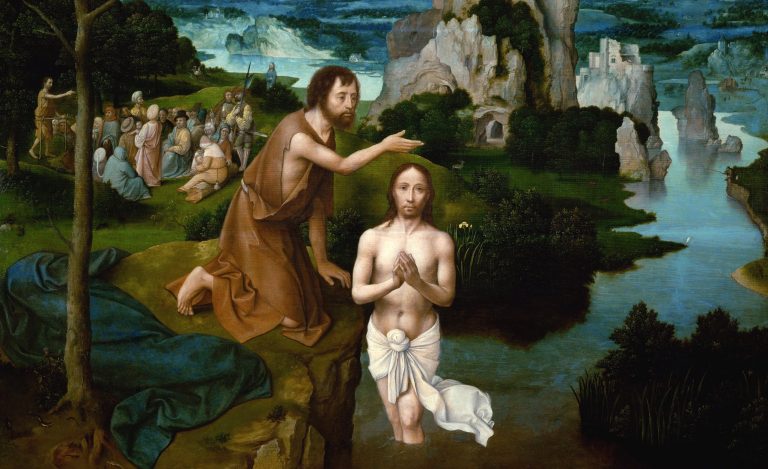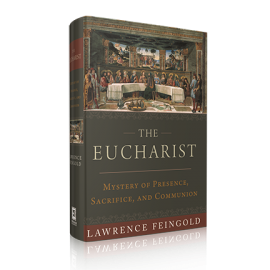By Lawrence Feingold
Dr. Lawrence Feingold is Associate Professor of Theology and Philosophy at Kenrick-Glennon Seminary in St. Louis. He is the author of numerous scholarly books, including The Eucharist: Mystery of Presence, Sacrifice, and Communion, a comprehensive commentary on the mystery of the Eucharist drawing from Scripture, the Church Fathers, and magisterial teaching throughout the ages.

The Word became flesh so that His humanity would be the instrument for the salvation of all men of all times. However, since Jesus lived as a man on this earth for a short time in a tiny part of the world, He desired some way to make Himself present as man to succeeding ages. While leaving us in the darkness of faith, with the corresponding possibility of merit, He still wishes that we truly encounter His humanity and its salvific power. The sacraments are the divinely appointed means for this encounter in faith. They offer this encounter with Christ by functioning as instruments of His humanity. They sanctify us by providing a mysterious contact with Christ’s humanity even after He has physically ascended into heaven.
The seven sacraments have a capacity to efficiently cause the grace they signify. But how can sensible signs cause grace? Since sanctifying grace is a participation in the divine nature (see 2 Pet 1:4), grace can be produced in a creature only through the omnipotence of God. How then are the sacraments true causes of grace? The problem would be insoluble without the notion of instrumental causality.
Philosophers speak of instrumental causality when a cause produces its effect by means of a subordinate agent. This subordinate agent is called an instrument or instrumental cause, which is an efficient cause that produces an effect higher than itself by executing a design that does not originate in itself but in a higher cause, referred to as the principal cause, which moves the instrument directly or indirectly. The artist’s paintbrush, for example, is an instrumental cause that executes an intention that originates in the artist’s mind, which is the principal cause of the artwork.
In living things, the organs are instruments of the soul to achieve its vital functions. Our senses, hands, feet, voice, and so on are all instruments of our soul. All human technology makes use of instruments and instrumental causality. All our tools are instruments to enhance the capacity of our natural instruments, which are our hands, eyes, ears, and other organs. The paintbrush is the instrument of the painter’s hand, which is the instrument of his imagination, intellect, and will. The telescope is an instrument of the eye, which is the instrument of the mind.
In other words, instrumental causality is present when, through the impulse and direction of a superior cause, an inferior cause is elevated above its own level, and made capable of producing an effect that transcends its proper capacity taken alone. Instrumental causes are moved movers, which can create effects only insofar as they are moved themselves by a higher cause, as the paintbrush is moved by the artist’s hand and mind.
There are many examples of instrumental causality in theology, for it occurs whenever anything acts as an instrument of God and of His plan. The sacred writers of the books of Scripture wrote as instrumental causes inspired by the Holy Spirit. Ultimately all creatures and their operations are instruments, each in their own way, of God’s providence, which directs all things to their ends for the realization of God’s plan in the universe. Even the humanity of Christ works as an instrumental cause moved by the divinity, and the sacraments also are clearly instrumental causes, serving as “extensions” of the humanity of Christ so that He can touch us today with the salvific power that He merited for us in His Passion.
During His public ministry Christ spoke with authority, and devils were expelled, winds were calmed, lepers healed, the blind were given sight, the sick healed, the dead were raised, and sinners were forgiven and reconciled. Theologians refer to these actions as “theandric,” which means divine-human. It is a term applied to certain actions of Christ in which we see the complementary operation of both natures, divine and human, at the same time, each acting in the way proper to it. We see this, for example, when Christ worked miracles. He spoke with His human voice and touched with His hands, but the power that caused the miracle came from His divine omnipotence. His human words and gestures were the instrument for the exercise of His divine power.
As the divine omnipotence alone can work miracles above the power of all creatures, so God alone is the principal cause of the infusion of grace in the soul that produces justification and sanctification. However, there is nothing to prevent God from producing this effect by means of instruments situated in the created and sensible order, as long as they are moved by Him, as were Jesus’s words and gestures when He worked miracles and when He instituted the Eucharist at the Last Supper. As the mind of the artist produces beauty in a statue by means of his hands and chisels, so God worked miracles through Christ’s words and gestures, and in like manner, He produces grace in the soul by means of Christ’s humanity (through which all grace was merited), and through the sacraments, as if they were chisels or paintbrushes in the hands of Christ.
You Might Also Like
 The Eucharist: Mystery of Presence, Sacrifice, and Communion explores the three ends of the Sacrament of Sacraments: God’s true presence, His redemptive sacrifice, and spiritual nourishment through communion with Him. In this follow-up to his groundbreaking work, Faith Comes From What Is Heard, Lawrence Feingold constructs a biblical vision of the Eucharist from its prefigurement in the Old Testament to its fulfillment in the New and presents the Eucharistic theology of the Church Fathers, St. Thomas Aquinas, and magisterial teaching from centuries past through today.
The Eucharist: Mystery of Presence, Sacrifice, and Communion explores the three ends of the Sacrament of Sacraments: God’s true presence, His redemptive sacrifice, and spiritual nourishment through communion with Him. In this follow-up to his groundbreaking work, Faith Comes From What Is Heard, Lawrence Feingold constructs a biblical vision of the Eucharist from its prefigurement in the Old Testament to its fulfillment in the New and presents the Eucharistic theology of the Church Fathers, St. Thomas Aquinas, and magisterial teaching from centuries past through today.

